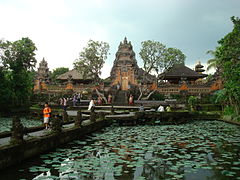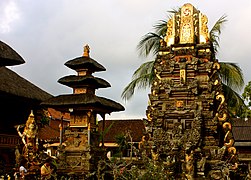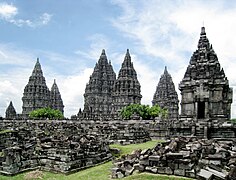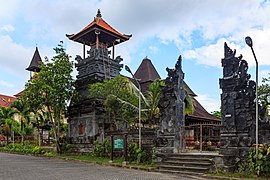Hinduism in Indonesia
Osing and other Indonesian languages |
| Part of a series on |
| Hinduism in Indonesia |
|---|
 |
|
|
History

The indigenous peoples of the
Arrival of Hinduism
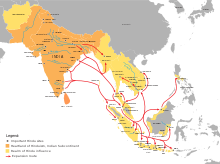
Hindu influences reached the

The two major theories for the arrival of Hinduism in Indonesia include that South Indian sea traders brought Hinduism with them, and second being that Indonesian royalty welcomed Indian religions and culture, and it is they who first adopted these spiritual ideas followed by the masses. Indonesian islands adopted both Hindu and Buddhist ideas, fusing them with pre-existing native folk religion and Animist beliefs.
Several notable ancient Indonesian Hindu kingdoms were
Hinduism in the colonial era

These Sultanates declared Islam as their state religion and fought against each other as well as the Hindus and other non-Muslims.[33][clarification needed] In some regions, Indonesian people continued their old beliefs and adopted a syncretic version of Islam. In other cases, Hindus and Buddhists left and concentrated as communities in islands that they could defend. Hindus of eastern Java, for example, moved to Bali and neighboring small islands.[34][failed verification] While this era of religious conflict and inter-Sultanate warfare was unfolding, and new power centers were attempting to consolidate regions under their control, European colonialism arrived.[35] The Indonesian archipelago was soon dominated by the Dutch colonial empire.[36] The Dutch colonial empire helped prevent inter-religious conflict, and it slowly began the process of excavating, understanding and preserving Indonesia's ancient Hindu-Buddhist cultural foundations, particularly in Java and western islands of Indonesia.[37]
Hinduism in modern era
After Indonesia gained its independence from Dutch colonial rule, it officially recognized only monotheistic religions under pressure from political Islam. Further, Indonesia required an individual to have a religion to gain full Indonesian citizenship rights, and officially Indonesia did not recognize Hindus.
Om tat sat ekam eva advitiyam
Translation: Om, thus is the essence of the all prevading, infinite, undivided one.— Joint petition by Hindus of Bali, 14 June 1958
The petition's focus on the "undivided one" was to satisfy the constitutional requirement that Indonesian citizens have a monotheistic belief in one God. The petitioners identified Ida Sanghyang Widhi Wasa as the undivided one. In the Balinese language this term has two meanings: the Divine ruler of the Universe and the Divine Absolute Cosmic Law. This creative phrase met the monotheistic requirement of the Indonesian Ministry of Religion in the former sense, while the latter sense of its meaning preserved the central ideas of dharma in ancient scripts of Hinduism.[43] In 1959, Indonesian President Sukarno supported the petition and a Hindu-Balinese Affairs section was officially established in the Ministry of Religious Affairs under the Djuanda Cabinet.[44]
Indonesian politics and religious affairs went through turmoil from 1959 to 1962, with Sukarno dissolving the Konstituante and weakening the impact of communist movement in Indonesia along with political Islam.[45] Nevertheless, officially identifying their religion as Hinduism was not a legal possibility for Indonesians until 1962, when it became the fifth state-recognized religion.[46] This recognition was initially sought by Balinese religious organizations and granted for the sake of Bali, where the majority were Hindu. Between 1966 and 1980, along with Balinese Hindus, large numbers of Indonesians in western Java, as well as parts of South Sulawesi, North Sumatra, Central and South Kalimantan officially declared themselves to be Hindus.[47] They politically organized themselves to press and preserve their rights.[48] The largest of these organizations, Parisada Hindu Dharma Bali, changed its name to Parisada Hindu Dharma Indonesia (PHDI) in 1986, reflecting subsequent efforts to define Hinduism as a national rather than just a Balinese concern.[49]
While Hindus in Bali, with their large majority, developed and freely practiced their religion, in other islands of Indonesia they suffered discrimination and persecution by local officials as these Hindus were considered as those who had left Islam, the majority religion. However, the central government of Indonesia supported the Hindus.[50] In the 1960s, Hinduism was an umbrella also used by Indonesians whose faith was Buddhism and Confucianism, but when neither of these two were officially recognized. Furthermore, Hindu political activists of Indonesia worked to protect people of those faiths under rights they had gained at the Indonesian Ministry of Religion.[51]
To gain official acceptance and their rights in a Muslim-dominated country, Hinduism in Indonesia was politically forced to adapt.
Folk religions and animists with a deep concern for the preservation of their traditional ancestor religions declared their religion to be Hinduism, considering it a more flexible option than Islam or Christianity, in the outer islands. In the early seventies, the
Compared to their counterparts among Javanese Hindus, many Dayak leaders were also more deeply concerned about Balinese efforts to standardize Hindu ritual practice nationally; fearing a decline of their own unique 'Hindu Kaharingan' traditions and renewed external domination.[55][56] By contrast, most Javanese were slow to consider Hinduism at the time, lacking a distinct organization along ethnic lines and fearing retribution from locally powerful Islamic organizations like the Nahdatul Ulama (NU).[57]
Several native tribal peoples with beliefs such as
In February 2020, President Joko Widodo issued a presidential regulation elevating the status of Hindu Dharma State Institute in Denpasar, Bali into the country's first Hindu state university, named I Gusti Bagus Sugriwa State Hindu University. This institution of Hindu higher study started out as a state academy for teachers of Hindu religion in 1993, before being converted into the Hindu Religion State College in 1999, and then into the Hindu Dharma State Institute in 2004.[61]
General beliefs and practices
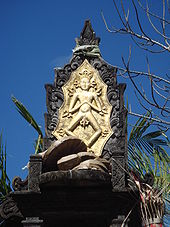

The general beliefs and practices of Agama Hindu Dharma are a mixture of ancient traditions and contemporary pressures placed by Indonesian laws that permit only monotheist belief under the national ideology of panca sila.[22][62] Traditionally, Hinduism in Indonesia had a pantheon of deities and that tradition of belief continues in practice; further, Hinduism in Indonesia granted freedom and flexibility to Hindus as to when, how and where to pray. However, officially, Indonesian government considers and advertises Indonesian Hinduism as a monotheistic religion with certain officially recognized beliefs that comply with its national ideology.[22][63][64] Indonesian school text books describe Hinduism as having one supreme being, Hindus offering three daily mandatory prayers, and Hinduism as having certain common beliefs that in part parallel those of Islam.[65][60] Scholars contest whether these Indonesian government recognized and assigned beliefs reflect the traditional beliefs and practices of Hindus in Indonesia before Indonesia gained independence from Dutch colonial rule.[66][67][68]
Some of these officially recognized Hindu beliefs include:
- A belief in one supreme being called 'Ida Sanghyang Widi Wasa', 'Sang Hyang Tunggal', or 'Sang Hyang Acintya'. God Almighty in the Torajanese culture of Central Sulawesi is known as "Puang Matua" in Aluk To Dolo belief.[69]
- A belief that all of the gods are manifestations of this supreme being. This belief is the same as the belief of genie lore of Muslims.[70]
- A belief in the Trimurti, consisting of:[71]
- A belief in all of the other Hindu gods and goddesses (Hyang, Dewata and Batara-Batari).[72]
The sacred texts found in Agama Hindu Dharma are the
Forms of Hinduism
Balinese Hinduism
Balinese Hinduism is an amalgamation of Indian religions and indigenous animist customs that existed in Indonesian archipelago before the arrival of Islam and later Dutch colonialism. The 
Balinese Hindu temple
Each individual has a family deity, called Kula dewa, who resides in the temple called the family temple that the individual and his family patronize. Balinese Hindu follow a 210-day calendar (based on rice crop and lunar cycles), and each temple celebrates its anniversary once every 210 days (the calendar is known as Pawukon calendar).[84][85] Unique rituals and festivals of Balinese Hindus, that are not found in India, include those related to death of a loved one followed by cremations, cockfights, tooth filings, Nyepi and Galungan. Each temple anniversary, as well as festivals and family events such as wedding include flowers, offerings, towering bamboos with decoration at the end and a procession. These are celebrated by the community with prayers and feast.[78] Most festivals have a temple as venue, and they are often occasions for prayers, celebration of arts and community. Some traditions, in contrast, involve animist rituals such as caru (animal blood sacrifice) such as Tabuh Rah (lethal cockfighting) or killing of an animal to appease buta kala (spirits of the earth) - however, the animal sacrifices are conducted outside the premises of a temple.[86][87]
Balinese Hindu art
Dance, music, colorful ceremonial dresses and other arts are a notable feature of religious expression among Balinese Hindus. As in India, these expressions celebrate various mudra to express ideas, grace, decorum and culture. Dance-drama is common. Various stories are expressed. For example, one involves a battle between the mythical characters Rangda the witch (representing adharma, something like disorder) and Barong the protective spirit represented with a lion mask (representing dharma), in which performers fall into a trance, the good attempts to conquer evil, the dancers express the idea that good and evil exists within each individual, and that conquering evil implies ejecting evil from oneself.[88] Balinese paintings are notable for their highly vigorous yet refined, intricate art that resembles baroque folk art with tropical themes.[89] The dance-drama regularly ends undecided, neither side winning, because the primary purpose is to restore balance and recognize that the battle between dharma and adharma (good and evil) is within each person and a never ending one.[90] Barong, or dharma, is a major symbolic and ritual paradigm found in various festivities, dances, arts and temples.[91]
Rituals of the life cycle are also important occasions for religious expression and artistic display. Ceremonies at puberty, marriage, and, most notably, cremation at death provide opportunities for Balinese to communicate their ideas about community, status, and the afterlife.[92]
Balinese Hindu society
Scholars dispute the degree and nature of social stratification in medieval and contemporary Balinese Hindu society.
Hinduism in Java

Both
The heritage of Hinduism left a significant impact and imprint in Javanese and Sundanese art and culture. The wayang puppet performance as well as wayang wong dance and other Javanese and Sundanese classical dances are derived from episodes of Hindu epics Ramayana and Mahabharata. Although the vast majority of Javanese and Sundanese now identify as Muslim, these art forms still survive. Hinduism has survived in varying degrees and forms on Java. Certain ethnic groups in Java, such as the Tenggerese and Osing, are also associated with Hindu religious traditions.[102]

Tengger Hindus of Java
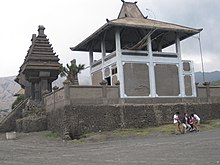
The
Osing Hindus of Java
In spite of the Dutch attempts to propagate Islam and Christianity among the
Hinduism elsewhere in the archipelago
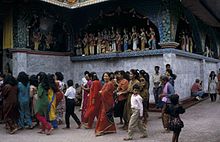
Among the non-Balinese communities considered to be Hindu by the government are, for example, the
A majority of the population on the small island of Tanimbar Kei practices a variant of the Hindu religion, which involves a form of ancestral worship. The island of Tanimbar Kei is not part of Tanimbar, as the name might suggest, but is one of the Kai Islands. As of 2014, it is inhabited by ca. 600 people.[112][113]
Demographics

The 2018 civil registration recorded the number of Hindus at 4,646,357 with some 90% of them residing in the Hindu heartland of Bali.
Outside Bali, Hindus form a majority in Tosari district (66.3%) in Pasuruan Regency in Java,[114] Balinggi district (77.3%) of Parigi Moutong Regency in Central Sulawesi,[114] Mappak (50%) in Tana Toraja Regency in South Sulawesi.[114] Significant Hindu population is also found in Torue (41%) and Sausu (30%) districts in Parigi Moutong;[114] Tomoni Timur (35%), Angkona (27%), Simbuang (36%)[114] and Tellulimpo E (40%) districts in South Sulawesi;[114] and Cakranegara district (39%) in Mataram in Lombok.[114]
Civil registration (2018)
According to the 2018 civil registration, there were a total of 4,646,357 Hindus in Indonesia, compared to the 4,012,116 Hindus in 2010 census.[115] The percentages of Hinduism in Indonesia increased from 1.69% in 2010 to 1.74% in 2018 in 8 years respectively.
| Province (2018 Cen.) | Total | Hindus | % Hindu |
|---|---|---|---|
| Indonesia | 266,534,836 | 4,646,357 | 1.74% |
| North Sumatra | 14,908,036 | 88,346 | 0.70% |
| West Sumatra | 5,542,994 | 93 | 0.002% |
| Riau | 6,149,692 | 739 | 0.012% |
| Jambi | 3,491,764 | 510 | 0.02% |
| South Sumatra | 8,267,779 | 40,319 | 0.49% |
| Bengkulu | 2,001,578 | 4,184 | 0.21% |
| Lampung | 9,044,962 | 127,903 | 1.47% |
| Bangka Belitung Islands | 1,394,483 | 1,193 | 0.09% |
| DKI Jakarta | 11,011,862 | 20,216 | 0.18% |
| West Java | 45,632,714 | 17,017 | 0.04% |
| Central Java | 36,614,603 | 15,648 | 0.043% |
| D.I. Yogyakarta | 3,645,487 | 3,418 | 0.09% |
| East Java | 40,706,075 | 107,971 | 0.27% |
| Banten | 10,868,810 | 8,292 | 0.08% |
| Bali | 4,236,983 | 3,682,484 | 86.91% |
| West Nusa Tenggara | 3,805,537 | 128,600 | 3.4% |
| East Nusa Tenggara | 5,426,418 | 6030 | 0.11% |
| West Kalimantan | 5,427,418 | 2,998 | 0.06% |
| Central Kalimantan | 2,577,215 | 155,595 | 5.84% |
| South Kalimantan | 2,956,784 | 23,252 | 0.79% |
| East Kalimantan | 3,155,252 | 8,311 | 0.26% |
| North Sulawesi | 2,645,118 | 15,525 | 0.58% |
| Central Sulawesi | 2,969,475 | 109,308 | 4.84% |
| South Sulawesi | 9,117,380 | 63,652 | 1.02% |
| Southeast Sulawesi | 1,755,193 | 50,065 | 2.97% |
| Gorontalo | 1,181,531 | 1,049 | 0.09% |
| West Papua | 1,148,154 | 1,164 | 0.1% |
| Papua | 4,346,593 | 3,341 | 0.08% |
Official Census (2010)
According to the 2010 Census, there were a total of 4,012,116 Hindus in Indonesia, compared to 3,527,758 Hindus in 2000 Census.[116] While the absolute number of Hindus increased, the relative percentage of Hindus in Indonesia decreased from 2000 to 2010 because of lower birth rates among the Hindu population compared to the Muslim population. The average number of births per Hindu woman varied between 1.8 and 2.0 among various islands, while for the Muslim population it varied between 2.1 and 3.2 per woman.


| Province | Total | Hindu 2010[117] | % Hindu 2010 | % Hindu 2000 | Change |
|---|---|---|---|---|---|
| Indonesia | 237,641,326 | 4,012,116 | 1.69% | 1.79% | |
| Aceh | 4,494,410 | 136 | 0.00% | 0.01% | -0.01% |
| Sumatera Utara | 12,982,204 | 80,644 | 0.65% | 0.57% | 0.08% |
| Sumatera Barat | 4,846,909 | 234 | 0.00% | 0.00% | 0.00% |
| Riau | 5,538,367 | 1,076 | 0.02% | 0.09% | -0.07% |
| Jambi | 3,092,265 | 582 | 0.02% | 0.02% | 0.00% |
| Sumatera Selatan | 7,450,394 | 39,206 | 0.53% | 0.26% | 0.27% |
| Bengkulu | 1,715,518 | 3,727 | 0.22% | 0.15% | 0.07% |
| Lampung | 7,608,405 | 113,512 | 1.49% | 1.44% | 0.05% |
| Kep. Bangka Belitung | 1,223,296 | 1,040 | 0.09% | 0.01% | 0.08% |
| Kepulauan Riau | 1,679,163 | 1,541 | 0.09% | 0.37% | -0.28% |
| DKI Jakarta | 9,607,787 | 20,364 | 0.21% | 0.23% | -0.02% |
| Jawa Barat | 43,053,732 | 19,481 | 0.05% | 0.02% | 0.03% |
| Jawa Tengah | 32,382,657 | 17,448 | 0.05% | 0.09% | -0.04% |
| DI Yogyakarta | 3,457,491 | 5,257 | 0.15% | 0.09% | 0.06% |
Jawa Timur
|
37,476,757 | 112,177 | 0.30% | 0.27% | 0.03% |
| Banten | 10,632,166 | 8,189 | 0.08% | 0.07% | 0.01% |
| Bali | 3,890,757 | 3,247,283 | 83.46% | 88.05% | -4.59% |
Nusa Tenggara Barat
|
4,500,212 | 118,083 | 2.62% | 3.03% | -0.41% |
| Nusa Tenggara Timur | 4,683,827 | 5,210 | 0.11% | 0.15% | -0.04% |
| Kalimantan Barat | 4,395,983 | 2,708 | 0.06% | 0.08% | -0.02% |
| Kalimantan Tengah | 2,212,089 | 11,149 | 0.50% | 5.89% | -5.39% |
| Kalimantan Selatan | 3,626,616 | 16,064 | 0.44% | 0.21% | 0.23% |
| Kalimantan Timur | 3,553,143 | 7,657 | 0.22% | 0.13% | 0.09% |
| Sulawesi Utara | 2,270,596 | 13,133 | 0.58% | 0.56% | 0.02% |
Sulawesi Tengah
|
2,635,009 | 99,579 | 3.78% | 4.84% | -1.06% |
Sulawesi Selatan
|
8,034,776 | 58,393 | 0.73% | 1.13% | -0.40% |
Sulawesi Tenggara
|
2,232,586 | 45,441 | 2.04% | 2.97% | -0.93% |
| Gorontalo | 1,040,164 | 3,612 | 0.35% | 0.00% | 0.35% |
| Sulawesi Barat | 1,158,651 | 16,042 | 1.38% | 1.88% | -0.50% |
| Maluku | 1,533,506 | 5,669 | 0.37% | NA | 0.00% |
| Maluku Utara | 1,038,087 | 200 | 0.02% | 0.02% | 0.00% |
| Papua Barat | 760,422 | 859 | 0.11% | 0.68% | -0.57% |
| Papua | 2,833,381 | 2,420 | 0.09% | 0.16% | -0.07% |
Official Census (2000)
According to the 2000 census, Hindus made up 1.79% of the total Indonesian population. Bali had the highest concentration of Hindus with 88.05% of its population professing Hinduism agama.[118]
The percentage of Hindus in the total population declined from the 1990 census, and this is largely attributed to lower birth rates and immigration of Muslims from Java into provinces with high Hindu populations.[119] In Central Kalimantan there has been progressive settlement of Madurese from Madura.[120] The details are given below:
| Province (2000 Cen) | Hindus | Total | % Hindu |
|---|---|---|---|
| North Sumatra | 68,907 | 11,429,919 | 0.57% |
| West Sumatra | 0 | 4,220,318 | 0.00% |
| Riau | 4,385 | 4,676,025 | 0.09% |
| Jambi | 410 | 2,386,866 | 0.02% |
| South Sumatra | 17,874 | 6,756,564 | 0.26% |
| Bengkulu | 2,033 | 1,396,687 | 0.15% |
| Lampung | 95,458 | 6,631,686 | 1.44% |
| Bangka Belitung Islands | 76 | 945,682 | 0.01% |
| DKI Jakarta | 19,331 | 8,482,068 | 0.23% |
| West Java | 8,177 | 35,279,182 | 0.02% |
| Central Java | 28,677 | 30,775,846 | 0.09% |
| D.I. Yogyakarta | 2,746 | 3,026,209 | 0.09% |
| East Java | 92,930 | 34,456,897 | 0.27% |
| Banten | 5,498 | 7,967,473 | 0.07% |
| Bali | 2,740,314 | 3,112,331 | 88.05% |
| Nusa Tenggara Barat | 115,297 | 3,805,537 | 3.03% |
| Nusa Tenggara Timur | 5,698 | 3,904,373 | 0.15% |
| West Kalimantan | 2,914 | 3,721,368 | 0.08% |
| Central Kalimantan | 105,256 | 1,785,875 | 5.89% |
| South Kalimantan | 6,288 | 2,956,784 | 0.21% |
| East Kalimantan | 3,221 | 2,414,989 | 0.13% |
| North Sulawesi | 10,994 | 1,972,813 | 0.56% |
| Central Sulawesi | 99,443 | 2,053,167 | 4.84% |
| South Sulawesi | 87,660 | 7,759,574 | 1.13% |
| Southeast Sulawesi | 52,103 | 1,755,193 | 2.97% |
| Gorontalo | 0 | 833,720 | 0.00% |
| Irian Jaya | 2,068 | 2,094,803 | 0.10% |
| Indonesia | 3,527,758 | 196,601,949 | 1.79% |
Hindu holidays in Indonesia

- Hari Raya Galungan occurs every 210 days and lasts for 10 days.[122] It celebrates the coming of the gods and the ancestral spirits to earth to dwell again in the homes of their descendants. The festivities are characterized by offerings, dances and new clothes.[123] The ancestors must be suitably entertained and welcomed, and prayers and offerings must be made for them. Families whose ancestors have not been cremated yet, but remain buried in the village cemetery, must make offerings at the graves. Kuningan is the last day of the holiday, when the gods and ancestors depart until the next Galungan.[124][125]
- Pawukon calendar.[127] Ceremonies and prayers are held at the temples in family compounds, educational institutions and temples, villages, and businesses from morning to noon. Teachers and students replace their uniforms for the day with bright and colorful ceremonial clothing, filling the island with color. Children bring fruit and traditional cakes to school for offerings at the temple.[128]
- Hari Raya Nyepi is a Hindu Day of Silence or the Hindu New Year in the Balinese Saka calendar. The largest celebrations are held in Bali as well as in Balinese Hindu communities around Indonesia. On New Year's Eve the villages are cleaned, food is cooked for two days and in the evening as much noise is made as possible to scare away the devils. On the following day, Hindus do not leave their homes, cook or engage in any activity. Streets are deserted, and tourists are not allowed to leave hotel complexes. The day following Nyepi night, everything stops for a day except emergency services such as ambulances.[129] Nyepi is determined using the Balinese calendar, the eve of Nyepi falling on the night of the new moon whenever it occurs around March/April each year. Therefore, the date for Nyepi changes every year. Nyepi night is a night of community gathering and burning of effigies island-wide (similar to Karthikai in South India), while the next day is the day of total peace and quiet.
Social life
A common feature among new Hindu communities in Java is that they tend to rally around recently built temples (pura) or around archaeological temple sites (candi) which are being reclaimed as places of Hindu worship.[130]
The Parisada Hindu Dharma changed its name to Parisada Hindu Dharma Indonesia in 1984, in recognition of its national influence spearheaded by Gedong Bagus. One of several new Hindu temples in eastern Java is Pura Mandaragiri Sumeru Agung, located on the slope of Mt. Semeru, Java's highest mountain. When the temple was completed in July 1992, with the generous aid of wealthy donors from Bali, only a few local families formally confessed to Hinduism. A pilot study in December 1999 revealed that the local Hindu community now has grown to more than 5000 households.
Similar mass conversions have occurred in the region around Pura Agung Blambangan, another new temple, built on a site with minor archaeological remnants attributed to the kingdom of
Although there has been a more pronounced history of resistance to
In
Tourism

The predominantly Hindu island of Bali is the largest tourist draw in Indonesia.[140] Next to natural beauty, the temple architecture, the elaborate Hindu festivals, rich culture, colorful art and vivid dances are the main attractions of Balinese tourism. As a result, tourism and hospitality services are flourishing as one of the most important sources of income and generation of Balinese economy.[141] The high tourist activity in Bali is in contrast with other provinces in Indonesia where the Hindu population is not significant or is absent.[142]
The Government of Indonesia also invests and focuses on the Ancient sites and buildings of Hindu religion, along with Buddhist ones.
Culture
Before
Temples
-
Prambanan, the largest Hindu temple compound in Indonesia.
-
Pura Jagat Natha.
The Hindu temple structure and architecture in Indonesia differs from the rest part of the world and has also quite diversity among them also.[146] The temples structures in Indonesia
- Candi, the Javanese ancient Hindu temple.[147] (This type of temple structure and architecture is mostly founded in Java and are place of worship for Javanese Hindus).
- Pura, the Balinese temples.[148] (A Pura is a Balinese temple and is place of worship for Balinese Hindus).
Symbolism

The
- The National emblem of Indonesia is called .
- There are many names of Hindu deities names, such as Wisnu, Surya, etc.[154]
Notable Hindus
Monarchs
- Kudungga
- Mulavarman
- Purnawarman
- Adityawarman
- Airlangga
- Anak Wungsu
- Agung Anom
- Anusapati
- Arjayadengjayaketana
- Ken Arok
- Balitung
- Dalem Baturenggong
- Dalem Ketut
- Dalem Samprangan
- Dharmawangsa
- Hayam Wuruk
- Isyana Tunggawijaya
- Jayabaya
- Jayakatwang
- Jayanegara
- Jayapangus
- Samara Vijayatunggavarman
- Sanjaya of Mataram
- Sanna
- Siliwangi
- Mpu Sindok
- Sri Baduga Maharaja
- Śri Wijaya Mahadewi
- Suhita
- Ide Anak Agung Gde Agung
Religious leaders
Modern-day Hindus
See also
- Acintya
- Balinese Hinduism
- Candi of Indonesia
- Hinduism in Java
- Hinduism in Southeast Asia
- Dewi Sri
- Hinduism in Bali
- List of Hindu empires and dynasties
- Hyang
- Indians in Indonesia
- List of Hindu temples in Indonesia
- Religion in Indonesia
- Sanskritization
- Trisandya
References
Notes
- ^ The lower number is based on Pew Research estimate and is primarily concentrated in the island of Bali, Indonesia and nearby provinces of Indonesia. The higher number is based on a 2010 estimate by the Ministry of Religious Affairs of the Government of Indonesia.[109] The largest Hindu organization in Indonesia Parisada Hindu Dharma Indonesia states that the Indonesian census greatly underestimates Hindu population, because predominantly Muslim nation of Indonesia does not recognize all forms of Hinduism, and only recognizes monotheistic Hinduism under its constitution.[144][145]
- ^ Most of the Hindu temple, or Mandir are found in India and other places. They have Gopuramas and Vimana. They have different architecture as compared to Balinese temple and Candi.[150]
Citations
- ^ "Jumlah Penduduk Menurut Agama" (in Indonesian). Ministry of Religious Affairs. 31 August 2022. Retrieved 29 October 2023.
Muslim 241 Million (87), Christianity 29.1 Million (10.5), Hindu 4.69 million (1.7), Buddhist 2.02 million (0.7), Folk, Confucianism, and others 192.311 (0.1), Total 277.749.673 Million
- ^ Religious Freedom Report - Indonesia U.S. State Department (2012)
- ISBN 978-0-7619-2729-7.
- ^ "Mahayana Buddhism: Buddhism in Indonesia". www.buddhanet.net. Archived from the original on 12 November 2020. Retrieved 7 February 2021.
- PMID 22438500.
- OCLC 1126059704.
- ISBN 978-0-8108-7456-5.
- ^ "Indonesia". U.S. Department of State. Retrieved 4 May 2021.
- OCLC 2116026.
- ^ Damle & Damle 2020, pp. 76–89.
- ISBN 978-0-8242-1094-6.
- ISBN 978-1-57607-770-2.
- ^ Jan Gonda, The Indian Religions in Pre-Islamic Indonesia and their survival in Bali, in Handbook of Oriental Studies. Section 3 Southeast Asia, Religions, p. 1, at Google Books, pp. 1-54
- ISBN 978-981-4517-82-9.
- ^ Pringle 2004, p. 7.
- ^ Picard & Madinier 2011, pp. 67–71.
- ^ Pringle 2004, pp. 11–24; Hefner 2018, pp. 23–26.
- ^ ISBN 978-90-04-04330-5.
- ^ Soekmono, R. (1973). Pengantar sejarah kebudayaan Indonesia (in Indonesian). Yayasan Kanisius. p. 119.
- ISBN 978-0-7425-6762-7.
- ISBN 978-0-7425-6762-7.
- ^ ISSN 1092-6690.
- ISBN 978-1-58839-524-5.
- S2CID 129818020.
- ISBN 978-979-26-2499-1.
- ^ Hefner 2018, p. 91.
- ^ Ramstedt 2005, pp. 89–93; Hefner 2018, pp. 98–103.
- ISBN 978-90-04-04330-5.
- ISSN 0971-751X. Retrieved 6 February 2021.
- ISBN 978-0691134840, pp. xvi
- ISBN 978-90-04-25348-3.
- ISBN 978-0-691-13484-0.
- ISBN 978-1-316-18436-3.
- ISBN 978-0-8248-3415-9.
- ISBN 978-9813018587
- )
- ISBN 978-0-300-10518-6.
- ^ Ramstedt 2005, p. 9-11.
- ^ Ramstedt 2005, p. 12.
- ^ Ramstedt 2005, pp. 13–15.
- ^ Ramstedt 2005, pp. 15–16; Pringle 2004, pp. 78–81.
- ^ Picard & Madinier 2011, pp. 56–74.
- ^ Ramstedt 2005, pp. 34–37.
- ^ "Balinese Hinduism - Bali.com - Religion of Harmony, Holy Water, Ancestors". Bali.com. 18 August 2020. Retrieved 7 February 2021.
- ^ Ramstedt 2005, pp. 12–16.
- S2CID 162277591.
- ^ Ramstedt 2005, pp. 17–18.
- S2CID 46562270.
- ^ Ramstedt 2005, pp. 57–56.
- ^ Ramstedt 2005, p. 17, 19-21.
- ^ Ramstedt 2005, pp. 17–20.
- S2CID 1636786. Archived from the original(PDF) on 28 August 2006. Retrieved 26 October 2006.
- Relations, United States Congress House Committee on International (2001). Annual Report on International Religious Freedom 2001: Report Submitted to the Committee on International Relations, U.S. House of Representatives and the Committee on Foreign Relations, U.S. Senate. U.S. Government Printing Office. p. 150.
- ISBN 978-90-04-17026-1.
- ^ "Special Feature: Meet The Hindus of Java - Magazine Web Edition October/November/December 2014 - Publications - Hinduism Today Magazine". www.hinduismtoday.com. Archived from the original on 12 November 2020. Retrieved 7 February 2021.
- ISSN 2196-8802.
- ISBN 978-0-19-539589-1.
- from the original on 27 January 2021. Retrieved 7 February 2021.
- ^ KUMAR 2014, pp. 78–79.
- ^ ISSN 1756-4255.
- ^ "Jokowi creates country's first Hindu state university". The Jakarta Post. Retrieved 7 February 2021.
- ^ Yamashita 2003, p. 56.
- ^ Yamashita 2003, pp. 58–61.
- ^ Picard & Madinier 2011, pp. 56–72.
- ^ Yamashita 2003, p. 70.
- ISBN 978-979-8357-00-8.
- ^ Picard & Madinier 2011, p. 111-114.
- ^ Yamashita 2003, pp. 71–72.
- ^ a b "Modi in Jakarta: How Muslim-majority Indonesia keeps its Hinduism alive". India Today. 30 May 2018. Retrieved 7 February 2021.
- ^ Kekai, Paul (2 February 2005). "Quests of the Dragon and Bird Clan: Wednesday, February 02, 2005". Sambali.blogspot.com. Retrieved 19 July 2010.
- ^ "Brahma Vishnu Mahesh Trimurti Puja - Rudraksha Ratna". www.rudraksha-ratna.com. Retrieved 7 February 2021.
- ISSN 1757-6547.
- ^ Ramstedt 2005, pp. 91–95.
- ISBN 978-3-662-48159-2.
- ^ "SINTA - Science and Technology Index". sinta.ristekbrin.go.id. Retrieved 7 February 2021.
- ISBN 978-979-744-740-3.
- ISSN 2685-614X.
- ^ ISBN 978-1-4629-1359-6.
- ^ Picard & Madinier 2011, p. Chapter-v.
- ^ Picard & Madinier 2011, p. chapter-vi.
- ^ ISBN 978-0-7946-0071-6.
- ^ Journal of Southeast Asian Studies. Cambridge University Press. 2003. p. 170.
- ISBN 978-0791077771, pp. 66
- JSTOR 236740.
- S2CID 126134279.
- ISBN 978-0-8248-6210-7.
- ISBN 978-0-8442-4910-0.
- ^ Eiseman, Fred and Margaret (1988). Woodcarving of Bali. Periplus.
- ^ Forge, Anthony (1978). "Balinese Traditional Paintings" (PDF). The Australian Museum. Archived (PDF) from the original on 20 December 2016. Retrieved 20 December 2016.
- ^ Belo, Jane (1966). Bali: Rangda and Barong. University of Washington Press.
- ISBN 978-0-8248-6210-7.
- ^ Yamashita 2003, p. 68.
- ^ Picard & Madinier 2011, p. Chapter-VI (56).
- ^ "Results | Scholars Portal Journals". journals.scholarsportal.info. Retrieved 7 February 2021.
- JSTOR 27863998.
- ^ Hefner 1990, p. 67.
- ISBN 978-0889369207, pp. 26-27
- ISBN 978-0824824501, Chapter 1
- ^ Picard & Madinier 2011, p. 781.
- ^ Hefner 1990, pp. 198–199; Ramstedt 2005, pp. 78–90; KUMAR 2014, pp. 41.
- ISBN 978-0300105186, pp. 21-83 and 142-173
- ^ a b Hefner 2018.
- ^ "Tengger: The ethnic minority which protects Hinduism in remote part of Indonesia!". CT. 8 February 2018. Retrieved 7 February 2021.
- ^ Kalpavriksha (26 December 2019). "The Tengger people of Java, descendants of Majapahit". Medium. Retrieved 7 February 2021.
- ISSN 0261-3077. Retrieved 7 February 2021.
- ^ Project, Joshua. "Osing in Indonesia". joshuaproject.net. Retrieved 7 February 2021.
- ISSN 1620-3224.
- ISBN 978-0-8442-9947-1.)
{{cite book}}: CS1 maint: others (link - ^ a b Indonesia: Religious Freedoms Report 2010, US State Department (2011), Quote: "The Ministry of Religious Affairs estimates that 10 million Hindus live in the country and account for approximately 90 percent of the population in Bali. Hindu minorities also reside in Central and East Kalimantan, the city of Medan (North Sumatra), South and Central Sulawesi, and Lombok (West Nusa Tenggara). Hindu groups such as Hare Krishna and followers of the Indian spiritual leader Sai Baba are present in small numbers. Some indigenous religious groups, including the "Naurus" on Seram Island in Maluku Province, incorporate Hindu and animist beliefs, and many have also adopted some Protestant teachings."
- ^ My Jakarta: Bhavana Sutrisna Tirtadinata The Jakarta Globe — March 14, 2009
- ^ "Babad Bali - Pelaks Nyepi". www.babadbali.com. Retrieved 8 February 2021.
- ^ Jayanti, Anes D.; Osozawa, Katsuya (2014). "Sasi in Kei Island: Transformation of Coastal Resources Managementby Community in Tanimbar Kei Island, Maluku, Indonesia". Jurnal Perikanan. 16 (1): 43–52.
- PMID 27445428.
- ^ a b c d e f g "Peringatan". sp2010.bps.go.id. Retrieved 6 February 2021.
- ^ "Statistik Umat Menurut Agama di Indonesia" (in Indonesian). Kementerian Agama Republik Indonesia. 15 May 2018. Archived from the original on 3 September 2020. Retrieved 15 November 2020.
Muslim 231.069.932 (86.7), Christian 20.246.267 (7.6), Catholic 8.325.339 (3.12), Hindu 4.646.357 (1.74), Buddhist 2.062.150 (0.77), Confucianism 117091 (0.03), Other 299617 (0.13), Not Stated 139582 (0.06), Not Asked 757118 (0.32), Total 237641326
- ^ The information in present in 2010 Indonesian census.
- ^ "Sensus Penduduk 2010 - Penduduk Menurut Wilayah dan Agama yang Dianut". sp2010.bps.go.id. Retrieved 27 May 2014.
- ^ Data Umat Hindu Tahun 2009 Archived 2012-04-25 at the Wayback Machine
- ^ Internal Displacement Monitoring Centre (IDMC) - Norwegian Refugee Council. "West and Central Kalimantan: Limited livelihood opportunities and failed compensation for lost property hamper recovery of Madurese returnees". Internal-displacement.org. Archived from the original on 31 July 2010. Retrieved 19 July 2010.
- ^ "Indonesia". State.gov. 19 September 2008. Retrieved 19 July 2010.
- ISBN 0-945971036
- ^ Focus on Indonesia. Information Division, Embassy of Indonesia. 1976. p. 31.
- ^ "Calendar Of Events". Bali Local Guide. Retrieved 8 February 2021.
- ISBN 978-1-4629-0873-8.
- ^ Ramstedt 2005, pp. 196–198.
- ISBN 978-0-945971-03-0.
- ISBN 978-0-521-88540-9.
- ^ "Bali Cultural Ceremony and Ritual". Balispirit.com. Retrieved 19 July 2010.
- ISBN 978-9796865710
- ISBN 978-0-8248-2779-3.
- ^ Pringle 2004, p. 17.
- ^ KUMAR 2014.
- ^ "Biographies,Sages, Rushis And Saints at FreeIndia". Archived from the original on 16 March 2008. Retrieved 8 February 2021.
- ^ KUMAR 2014, pp. 89–123; Hefner 1990, pp. 137.
- ^ Devi, Sita W. "Tracing the glory of Majapahit". The Jakarta Post. Archived from the original on 28 July 2020. Retrieved 8 February 2021.
- ^ "10 Most Beautiful Temples in Indonesia". Touropia. Archived from the original on 1 December 2020. Retrieved 8 February 2021.
- ^ "Special Feature: Exploring the Temples of Java, Indonesia - Magazine Web Edition January/February/March 2015 - Publications - Hinduism Today Magazine". January 2015.
- ISBN 978-0-8248-3052-6.
- )
- ^ "Foreign Tourist Arrivals to Indonesia Jump 22.6% in January 2014 | Indonesia Investments". www.indonesia-investments.com. Retrieved 8 February 2021.
- ISBN 978-1-4629-0008-4.
- ^ "Statistics - Dinas Pariwisata". 7 September 2016. Archived from the original on 7 September 2016. Retrieved 6 February 2021.
- ^ Hefner 1990, p. 10 (page end).
- ^ F.K. Bakker (1997), Balinese Hinduism and the Indonesian State: Recent Developments, Bijdragen tot de Taal-, Land- en Volkenkunde, Deel 153, 1ste Afl., Brill Academic, pp. 15–41
- ISBN 978-0-7007-1533-6.
- ISBN 978-0-7619-2729-7.
- ^ "Temples in Bali - Bali Directory - Information about resources in Bali - Designed and Managed by bali3000". www.bali3000.com. Archived from the original on 11 May 2010. Retrieved 4 May 2021.
- ^ "JOURNAL OF THE SOCIETY OF ARCHITECTURAL HISTORIANS OF JAPAN". www.jstage.jst.go.jp. Retrieved 4 May 2021.
- ^ KUMAR 2014, p. 56.
- ^ Yamashita 2003, p. 198.
- ^ "State Emblem". Indonesia.go.id. Retrieved 23 March 2012.
- ^ Putri, Edira. "Garuda: Indonesia's Legendary Bird and National Emblem". Culture Trip. Retrieved 6 February 2021.
- ^ "'Garuda Luka' Serang Prabowo-Hatta Lewat Dunia Maya". Tribunnews.com (in Indonesian). Retrieved 6 February 2021.
- ^ Pringle 2004, p. 31.
Further reading
- Ramstedt, Martin (28 June 2005). Hinduism in Modern Indonesia. Routledge. OCLC 1037796224.
- Pringle, Robert (2004). A Short History of Bali: Indonesia's Hindu Realm. Allen & Unwin. OCLC 1098586627.
- KUMAR, RAVI (1 January 2014). Hindu Resurgence in Indonesia: Inspiring Story of Millions of Muslims converting to Hinduism. Suruchi Prakashan. ISBN 978-93-81500-47-7.
- Picard, Michel; Madinier, Rémy (13 May 2011). The Politics of Religion in Indonesia: Syncretism, Orthodoxy, and Religious Contention in Java and Bali. Routledge. ISBN 978-1-136-72640-8.
- OCLC 1018083561.
- Damle, Amod N.; Damle, Nilu H. (22 October 2020). Culture of Inequality: The Changing Hindu–Muslim Relations in Maharashtra. Taylor & Francis. ISBN 978-1-000-21703-2.
- Yamashita, Shinzi (2003). Bali and Beyond Explorations in the Anthropology of Tourism. Berghahn Books. pp. 56–72. ISBN 9-781-571-81327-5.
- OCLC 1166968690.
External links
- Hinduism in Indonesia
- Hindu Council UK: "Great Expectations: Hindu Revival Movements in Java and other parts of Indonesia" by Thomas Reuter
- Hindu Resources and Community in Indonesia
- Hindu-raditya.com
- Desadaat

